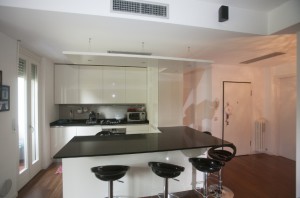Home restyling is an important business area for household appliances. After deciding to restructure their house, people often decide to change their old appliances with new and more efficient ones.

The economic crisis of the last years, has often made prohibitive to many families the purchase of a new house. So people sometime decide to restructure their old homes.
The skill and expertise of highly experienced professionals, in fact, are able to transform old buildings into jewels of modern architecture, equipped with the most advanced technological devices. In this process, the makeover has two purposes: renewing furniture and appliances, but also responding to new social needs.
The designer must harmonize all these elements masterfully, translating the wishes of consumers with the best proposals offered by the market.
“Who takes advantage of our advice – Umberto Nicolini, architect and designer, tells – has normally a keen interest and a particular care for the home and the details that make it up. Our role is to listen to the needs and desires of the customer and suggest him solutions that integrate the best furniture with advanced appliances, in accordance with the available space and safety regulations”.
Working in the renovation of many kind of houses and apartments, architect Nicolini has identified essentially two different trends in people choices. On the one hand there is a sort of space evolution, that is redefining the role of every room within the house. On the other hand, there is instead an organizational and technical transformation of the lodging itself.
Kitchen, for example, has been changed significantly since the Second World War to the present, transforming from a functional space to a more and more comfortable and sophisticated room.
The choice of new household appliances

All the house details are becoming more and more important for their inhabitants that choose everything with a particular care.
“Normally –Nicolini explains – people look very much to the aesthetic characteristics of furniture and appliances, while they are often misinformed about technical specifications. The aesthetic taste of people is also the basis of the selection of a built-in or a free standing style.
There are users who prefer simple and essential kitchens, while others choose solutions totally disappearing. There are, however, also interesting hybrid solutions, such as built-in refrigerators with visible doors or kitchens with built-in cooktops but free-standing refrigerator.
Nowadays, you can get great results of a very special appeal restyling an old house, responding to the taste and needs of all users. Recently, we happened to design a kitchen in an attic where we just adopted a hybrid solution. The room included a kitchen and a free standing sink, a central island with an additional induction hob and another area specifically dedicated to the refrigeration appliances, with built-in fridge and wine cellar”.
| Trade has deeply changed too The advent of low-cost furniture and household appliances chains and buying groups has upset the all house market. It led on the one hand to the wide penetration of some kind of furniture once reserved for the upper classes, such as built-in kitchens. On the other hand, however, has forced the traditional retailers to rethink completely their trade policies and assortments to recover lost market shares. So there is a reorganization of the sector which also influences the sale of household appliances. |
The future of home appliances market
The data related to the sales of household appliances in the world, in 2013, show a still alive, dynamic and full of prospects global market.
Even in Europe, where for months and months the economic crisis and decrease of appliances demand have been very strong, last year we saw in many cases an increase or a stabilization of national markets, especially with regard to the white goods and small domestic appliances.
Brown goods is still in a critical situation, in particular in the western part of the Old Continent, although even here, we can note a few faint signs of recovery.
A very interesting trend is visible instead in Eastern Europe, in Indonesia and South America.
Outside of Europe, the market trend of the home appliances was last year full of positive signs, with significant increases in sales, especially in those areas where the sector still has a relatively small value, but is in rapid development. In Argentina, for example, white goods sales reached a total value of 1,139 million euro, an increase of almost 30% compared to 2012.
Germany remains the largest household appliances market in Europe, with a value of more than 8 billion euro for white goods (+1.4%), approximately 8.6 billion for brown goods (-16.8) and 3.4 billion for small domestic appliances (+4.7%).
The United Kingdom, however, has maintained a turnover almost stable for the major appliances, amounting to approximately 4.5 billion euro (+0.9%), but has registered an increase of 5.2% in sales of small appliances, which reached 2.5 billion euro. Even in the British Isles brown goods has decreased, but less than before (-9.3%).
Italy has proven to be a strong market, with a decline of only 0.2% in white goods, which have reached a value of about 3.2 billion euro, while small domestic appliances have exceeded a turnover of one billion euro. Conversely, consumer electronics had once again a sharp contraction of 18.6%, the highest of the countries surveyed.
Spain, which has shown in the first months of 2014 a great impetus to the recovery, ended 2013 with a decline of 7.9% for major domestic appliances, 1.4% for the small ones and 15.7% for brown goods. France remains, by value, the second largest household appliance market after Germany, touching at the end of 2013, 5.1 billion euro in the sale of with goods (-2.1%) and 2.3 billion in the sales of small appliances (+0.4%). The sell-out of the consumer electronics products is instead dropped by 13.9%, falling to about 4.7 billion. More dynamic has been the Eastern area of the Old Continent, which has seen the growth of small markets in developing countries, where the demand for consumer electronics begins to get interesting. This is the case of Hungary, which, thanks to the switch off of the analogue signal, reported in this segment an increase by 25.2%, reaching 247 million euro. Lesser, but still considerable, even the increase of major and small domestic appliances, corresponding respectively to 7.1% and 18.4%.
Russia recorded a +8.7% in the sales of white goods, with a value of around 5 billion euro, an increase of 6.8% in those of small domestic appliances (2.3 billion euro) and of 1.5% in consumer electronics area (about 6.3 billion).
Far from Europe, Vietnam, Argentina and South Africa show a very good trend, recording sales of white goods for a value between 500 million and 1.5 billion euro, in all cases with a substantial two digit increase.
Vietnam has totalized 671 million euro in the sale of major appliances, with a growth of 27.9% compared to 2012, in line with the small appliances (111 million euro, +20.3%) and brown goods (685 million euro, +22.2%).
Indonesia, China and South Korea, finally, have recorded growth rates between 6 and 10% in white goods and slightly less than 10% in brown goods, with the exception of Korea, where there has been a drop of 26.3%. It should however be underlined the positive trend of small appliances, that in the three countries mentioned recording increases between 18 and 35%.
| What about the real estate market? Regardless of the economic crisis, which certainly has a great influence in the sale of residential market, it is evident the European trend to stop consuming land with the construction of new buildings. Although currently buying a new home is still less expensive than restructuring an old one, the tendency will be to reduce the gap between the two charges to encourage the renovation and restoration of old structures, which will be redesigned with new generation solutions. |



